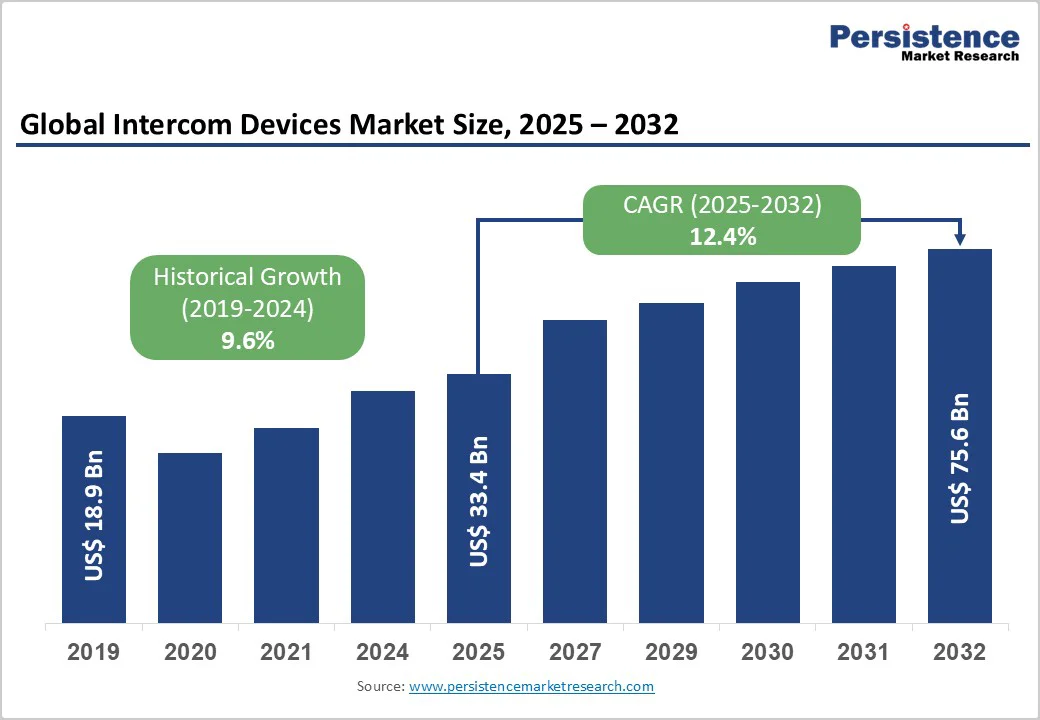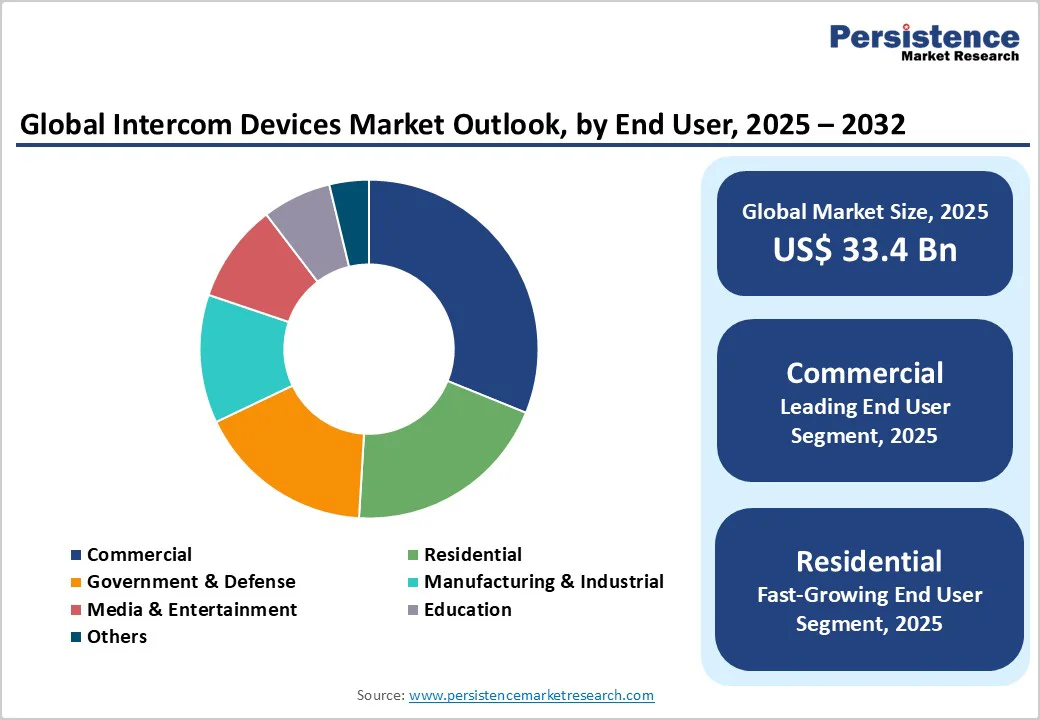ID: PMRREP33556| 192 Pages | 27 Nov 2025 | Format: PDF, Excel, PPT* | IT and Telecommunication

The global intercom devices market size is valued at US$33.4 billion in 2025 and projected to reach US$75.6 billion at a CAGR of 12.4% during the forecast period from 2025 to 2032.
With rising concerns over safety and access control, intercom systems enable instant connectivity between entry points and occupants, enhancing security management. The adoption of smart building technologies and IoT-enabled devices is further driving demand, allowing seamless integration with surveillance and automation systems. Rapid urbanization and infrastructure development are creating opportunities for advanced intercom solutions.
| Key Insights | Details |
|---|---|
| Intercom Devices Market Size (2025E) | US$33.4 Bn |
| Market Value Forecast (2032F) | US$75.6 Bn |
| Projected Growth (CAGR 2025 to 2032) | 12.4% |
| Historical Market Growth (CAGR 2019 to 2024) | 9.6% |

Rapid urbanization and rising security threats are fueling demand for advanced intercom systems. Expansion of residential complexes, commercial buildings, and smart cities, coupled with increasing incidents of theft, burglary, and unauthorized access, is prompting the adoption of intercoms integrated with video surveillance, smart locks, and alarm functionality.
In the UK, the Crime Survey for England and Wales (year ending September 2024) reported approximately 9.5 million incidents of theft, robbery, and other crimes, highlighting the need for secure living and work environments. Globally, over half the population now resides in urban areas, a figure expected to approach 70% by 2050, noted by the UN, further reinforcing the role of intercoms in modern urban infrastructure and property security.
The integration of smart home technologies and IoT ecosystems is accelerating the adoption of intercom devices. Consumers increasingly seek interconnected systems where intercoms work with smart locks, doorbells, cameras, and voice assistants like Alexa and Google Home, enabling real-time communication, visitor authentication, and remote access.
IoT-enabled intercoms with mobile app connectivity, cloud monitoring, and automation features are gaining popularity, supported by global smart home penetration surpassing 45% in 2025. Advancements in wireless standards such as Wi-Fi 6 and Zigbee further enhance reliability, positioning intercoms as intelligent, multifunctional home security hubs.
Government regulations and smart city initiatives are increasingly mandating advanced telecommunication and security infrastructure in buildings, driving adoption. For instance, under India’s Smart Cities Mission, 100 cities have completed 7,380 out of 8,075 projects with an investment of 1,47,704 crore as of December 2024.
State-level building bye-laws, such as Karnataka’s 2024 amendment and Maharashtra’s mandate, require telecom rooms and wiring for new constructions, with occupancy certificates withheld for non-compliance. Intercom devices, integrated with IoT platforms, provide real-time monitoring, visitor management, and automated access control, making them essential for regulatory compliance and smart building ecosystems.
Cybersecurity vulnerabilities and data privacy concerns are limiting adoption, as IoT-connected intercoms integrated with smart home and enterprise platforms are susceptible to hacking, unauthorized access, and data breaches. Regulatory compliance with GDPR and CCPA adds complexity and cost for manufacturers.
According to a study, over 50% of IoT devices currently have critical vulnerabilities, while the global shortage of cybersecurity professionals is ~4.8 million (2024), with only ~14% of organizations having the skilled workforce to address current cybersecurity challenges.
Such security apprehensions slow adoption, especially in residential and high-security commercial environments, compelling manufacturers to invest heavily in robust encryption, secure authentication, and real-time monitoring solutions.
The integration of artificial intelligence (AI) and biometric authentication is transforming intercom devices into intelligent security and management systems. AI enables real-time facial recognition, behavioral analysis, and anomaly detection, while biometric methods like fingerprint, iris, and facial scanning provide secure, contactless access.
These technologies allow seamless integration with smart homes and enterprise ecosystems, supporting automated visitor management and real-time alerts. Over 80% of organizations report using biometric authentication, with 70% considering it more secure than passwords, highlighting strong adoption potential.
The rising demand for smart, secure, and automated building solutions presents significant growth opportunities for manufacturers and technology providers globally.
The shift toward cloud-based intercom solutions and mobile integration is expanding addressable markets by enabling remote access, real-time updates, and centralized management via smartphones and tablets. Users increasingly expect seamless interaction between door stations, cameras, smart locks, and alarm systems, driving demand for wireless, mobile-integrated solutions.
Cloud platforms support subscription-based models, offering manufacturers recurring revenue while giving customers scalable, flexible systems. Advanced features like remote visitor authentication, automated alerts, and smart home integration enhance user convenience and engagement, creating new monetization avenues and growth opportunities for market players.
Video Intercoms Driving Enhanced Security, Real-Time Monitoring, and Controlled Access
Videos are expected to account for more than 73% share & accounting over US$ 24 Bn in 2025 due to the increasing need for enhanced security and real-time communication. They allow visual verification of visitors, reducing the risk of unauthorized access.
The demand is further driven by the need for convenience and efficient monitoring, as video intercoms provide clear, immediate visual information. Growing awareness of security threats and the importance of controlled access also contributes to their widespread adoption.
Audio is projected to grow at a significant rate, driven by its affordability, simplicity, and suitability for basic communication needs. It provides reliable two-way communication at lower price points, making it attractive to budget-conscious customers.
With straightforward installation requirements that eliminate complex wiring, it reduces both initial investment and setup time. In multi-tenant buildings and offices, audio intercoms ensure instant connectivity and enhanced security.
Wired Intercoms Leading with Stability, and Consistent Connectivity
Wired dominates, commanding over 60% market share in 2025, driven by its superior reliability, consistent performance, and enhanced security attributes.
Wired systems utilizing dedicated cabling infrastructure provide stable, interference-free communication unaffected by wireless signal disruptions, making them preferred choices for mission-critical security applications. The elimination of battery dependencies ensures uninterrupted operation during power outages when integrated with backup power systems, addressing critical reliability requirements.
Wireless is projected to grow at the highest rate due to the increasing demand for flexible, easy-to-install systems that eliminate the need for complex wiring and renovations. These systems support integration with mobile apps, cloud platforms, and IoT devices, enabling remote monitoring, automated access control, and real-time communication.
Advanced wireless protocols, including Wi-Fi 6, Bluetooth 5.0, and mesh networking, address historical concerns regarding signal range, interference, and reliability, allowing wireless solutions to compete effectively with wired alternatives in performance-critical applications.
Smart and Scalable Intercom Systems Driving Operational Efficiency in Commercial Spaces
Commercial are expected to account for more than 35% share with value reaching more than US$ 11.7 Bn in 2025, due to the growing need for efficient communication, security, and visitor management in offices, retail spaces, hospitals, and educational institutions. Businesses increasingly require centralized and scalable intercom systems to coordinate operations, monitor access points, and ensure employee and visitor safety.
Rising adoption of smart building solutions and compliance with workplace safety regulations further drive demand. Intercoms integrated with mobile apps and cloud-based management enhance operational efficiency, making them essential for commercial environments.
Residential is expected to grow at a CAGR of 15.1% propelled by smart home adoption, rising security consciousness, and declining technology costs, making advanced systems accessible to mainstream consumers.
Single-family homes, condominiums, and apartment complexes increasingly specify video intercom systems with mobile app connectivity, enabling residents to screen visitors, grant access remotely, and receive delivery notifications regardless of physical location. The residential segment benefits from consumer preferences for DIY installation options and wireless systems that minimize installation complexity while delivering professional-grade security capabilities.

North America is projected to account for over 34% with a value reaching ~ US$ 11.4 billion by 2025, led by the U.S., which accounts for more than 72% share. Strong security awareness, robust infrastructure, and early adoption of smart home and IoT technologies drive deployments.
The government's focus on homeland security and crime reduction is evident from the U.S. Bureau of Justice Statistics reporting 23.3 violent victimizations per 1,000 persons in 2024, and Canada’s crime severity index of 77.89 supports the adoption of advanced IP-based intercom systems.
Smart city initiatives and the need to replace aging analog systems further fuel demand, while North American manufacturers lead in AI-powered facial recognition, cloud-based management, and integrated security solutions.
Asia Pacific is the fastest-growing region, with a projected CAGR of 16.3% during the forecast period, driven by rapid urbanization, infrastructure expansion, and a growing middle class investing in home and building security. The region’s residential towers, gated communities, offices, hospitals, and public spaces increasingly adopt intercoms as part of access control and building-automation systems.
Government-led initiatives, such as India’s Smart Cities Mission with 100 operational ICCCs, 84,000+ CCTV cameras, emergency call boxes, and public address systems, further boost demand. China’s smart-city and digital infrastructure programs, alongside widespread 4G/5G networks in South Korea and enterprise private 5G deployment, support advanced video, mobile, and cloud-based intercom solutions.
Europe’s intercom devices market is driven by stringent security and data privacy regulations, including GDPR, alongside robust construction and smart building initiatives in countries like Germany, the UK, France, and Spain. Manufacturers focus on encrypted communication, privacy-by-design, and energy-efficient PoE systems to meet regulatory and sustainability requirements.
Premium, design-conscious intercoms that integrate with building management systems are increasingly favored, especially in commercial offices and retail spaces. Regulatory frameworks, such as EN 17210:2021 and the Energy Performance of Buildings Directive, further propel adoption, with 70.9% of EU residents using internet-connected devices and 11.8% adopting smart home security solutions in 2024 according to European Union.

The intercom devices market is largely fragmented, with numerous global and regional players competing aggressively. Manufacturers focus on product differentiation by integrating advanced features such as mobile app control, cloud-based management, and AI-driven security. They are forming strategic partnerships with technology and infrastructure providers, adopting aggressive pricing strategies for cost-sensitive markets, and expanding into emerging regions.
The global intercom devices market is projected to be valued at US$33.4 Bn in 2025.
The growing need for efficient communication, enhanced security, and seamless access management is a key driver of the market.
The intercom devices market is poised to witness a CAGR of 12.4% from 2025 to 2032.
Advancements in cloud-based management and AI-driven features, which expand functionality, are creating strong growth opportunities.
Aiphone Corporation, Comelit Group S.p.A., Honeywell International Inc., Panasonic Corporation, Legrand Holding Inc., Zenitel Group are among the leading key players.
| Report Attribute | Details |
|---|---|
| Historical Data/Actuals | 2019 - 2024 |
| Forecast Period | 2025 - 2032 |
| Market Analysis | Value: US$ Bn/Mn, Volume: As Applicable |
| Geographical Coverage |
|
| Segmental Coverage |
|
| Competitive Analysis |
|
| Report Highlights |
|
By Product Type
By Connectivity
By End-user
By Region
Delivery Timelines
For more information on this report and its delivery timelines please get in touch with our sales team.
About Author